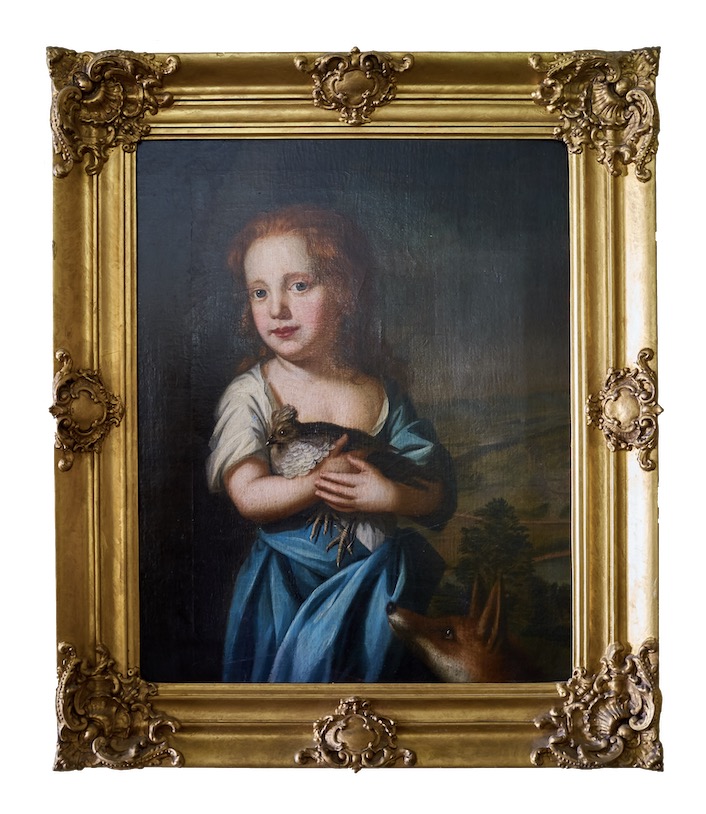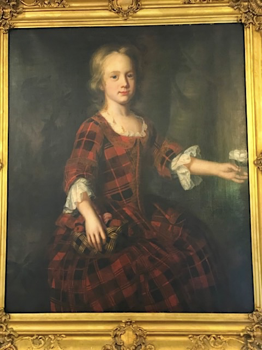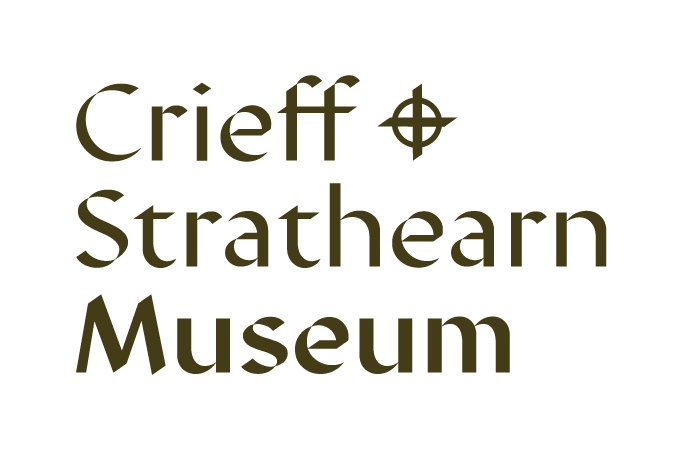The Jacobites - June - October 2019
Below are extracts from the town hall satellite display for the Perth Museum summer exhibition.

This painting of Joanna Murray is one of a pair. Painted by Catherine Read, it is thought to be contemporary with her portrait of Joanna's sister, Helen, dating from 1756. The portrait of Helen formed part of the main summer exhibition in the Perth Museum and Art Gallery: Jacobite Clans (29/06/2019 - 26/10/2019).
https://www.culturepk.org.uk/whats-on/jacobite-clans-ancestors-at-war/
There was a satellite exhibition about the Jacobites of the Crieff area which ran at the Strathearn Community Campus for the same period as Perth’s exhibition.
https://www.pkc.gov.uk/article/18840/What-s-on-at-Strathearn-Community-Campus-
The print of the portrait of Joanna, information about Jacobite families and about Catherine Read were displayed at the Crieff & Strathearn Museum desk at the Crieff Old Town Hall from the 19th of August until October 26th.
You can hear an interview with Tony and Sue Murray talking about the paintings and the sitters at: https://vimeo.com/353217125
There is also a regular podcast available for the Perth summer exhibition on the Jacobites at this address:
https://podcasts.apple.com/gb/podcast/jacobite-clans/id1474783253
Although the exhibitions have now finished, we recommend listening to Dr. Nicola Small's podcasts which are excellent.
https://www.culturepk.org.uk/whats-on/jacobite-clans-ancestors-at-war/
There was a satellite exhibition about the Jacobites of the Crieff area which ran at the Strathearn Community Campus for the same period as Perth’s exhibition.
https://www.pkc.gov.uk/article/18840/What-s-on-at-Strathearn-Community-Campus-
The print of the portrait of Joanna, information about Jacobite families and about Catherine Read were displayed at the Crieff & Strathearn Museum desk at the Crieff Old Town Hall from the 19th of August until October 26th.
You can hear an interview with Tony and Sue Murray talking about the paintings and the sitters at: https://vimeo.com/353217125
There is also a regular podcast available for the Perth summer exhibition on the Jacobites at this address:
https://podcasts.apple.com/gb/podcast/jacobite-clans/id1474783253
Although the exhibitions have now finished, we recommend listening to Dr. Nicola Small's podcasts which are excellent.
CATHERINE (Katherine) READ, portrait artist, 1723 - 1778
Above is a photograph of the portrait of Joanna Murray which is one of a pair of paintings attributed to Miss Read from the Murray Collection (1); the other is of Joanna’s older sister Helen. The latter may be seen at the Perth Museum & Art Gallery where it features in their summer exhibition on The Jacobites.

Catherine was born in Dundee to Alexander Reid of [Turfbeg and Logie] and Elizabeth Wedderburn [Blackness]. Elizabeth was the daughter of Sir John Wedderburn Bt. and niece of the 5th Laird of Blackness, also John, who was executed after Culloden. Catherine took charge of his daughters and helped to support them in later life with her earnings from painting and drawing.
Catherine began her career painting portraits for local Jacobite families, chiefly children and ladies. In 1745 she is said to have painted Isabella and Andrew Lumsden (secretary to Charles Edward Stuart after Culloden) and was said to have been in love with Andrew. Later there were many Wedderburn portraits undertaken.
Catherine was already recognised as having a gift when she travelled to Paris and studied the work of French artists and was introduced into Parisian artistic society. Here she became especially adept in the use of pastels (crayon). Catherine’s associations in Paris meant she received support and encouragement from well-connected people and received commissions. It is also said that she was a pupil of La Tour (2). The “Pretender’s” expulsion from France in 1751 prompted a move to Italy where Catherine found work painting society portraits, including gentlefolk taking The Tour.
It is important to recognise how unusual it was for a woman to travel “alone” and especially rare for a young woman to paint portraits for money; she was something of a pioneer in this respect. That said, much of the work she undertook in Italy is said to have been as gifts; Society of the time despised those who expected payment… One can only imagine how much more difficult it was for a woman, who relied upon her income from commissions (3). Her friend in Italy, the Abbe Peter Grant wrote: “Was it not for for the restrictions her sex obliges her to be under… would shine wonderfully in history painting too, but… impossible to attend publick academies or even design or draw from Nature… confine herself to Portraits and one branch of History painting… of single figures” and “continue here… only if chaperoned by some trusty friend”. She found the situation less strict in Naples but of the Carthusians “… these superstitious Biggotts won’t allow a female creature to enter their doors”.
In 1753 Catherine left Rome and returned to England, passing through Florence, Venice and Paris. She aspired to equal Rosalba or La Tour and she received great plaudits such as the “British Rosalba” when she established her studio in London. She became a much sought after portraitist in England and, in 1754 she was appointed “Paintress the the Queen” when she painted a portrait of Queen Charlotte. In 1763 she painted another portrait of Queen Charlotte with the infant Prince of Wales. 1764, she travelled to Paris, where she was made “Painter in Crayons to her Majesty” and the royal princesses sat to Miss Read in the following year.
Society is fickle and Catherine Read fell from favour in time. Unkind comments were made about her dress and demeanour and she was said to endow her subjects with childlike features which made it difficult to guess the age of the sitter from the portrait. While the demand for Catherine’s work dwindled, her niece Helena Beatson’s painting and drawing skills were becoming recognised. In 1777 they both travelled to India where Catherine’s brother was a surgeon in the service of the East India Company. Catherine was well received but there is scant information on the work she did there. Her niece Helena quickly found herself a husband and is said to have then neglected Catherine, who decided to return to England. She embarked with her brother William at Negatapam in 1778 but two months into the journey she died and was buried at sea.
Catherine Read’s legacy as an artist is considerable but as a single Scottish (Jacobite) woman artist, her story is a truly remarkable one.
Catherine began her career painting portraits for local Jacobite families, chiefly children and ladies. In 1745 she is said to have painted Isabella and Andrew Lumsden (secretary to Charles Edward Stuart after Culloden) and was said to have been in love with Andrew. Later there were many Wedderburn portraits undertaken.
Catherine was already recognised as having a gift when she travelled to Paris and studied the work of French artists and was introduced into Parisian artistic society. Here she became especially adept in the use of pastels (crayon). Catherine’s associations in Paris meant she received support and encouragement from well-connected people and received commissions. It is also said that she was a pupil of La Tour (2). The “Pretender’s” expulsion from France in 1751 prompted a move to Italy where Catherine found work painting society portraits, including gentlefolk taking The Tour.
It is important to recognise how unusual it was for a woman to travel “alone” and especially rare for a young woman to paint portraits for money; she was something of a pioneer in this respect. That said, much of the work she undertook in Italy is said to have been as gifts; Society of the time despised those who expected payment… One can only imagine how much more difficult it was for a woman, who relied upon her income from commissions (3). Her friend in Italy, the Abbe Peter Grant wrote: “Was it not for for the restrictions her sex obliges her to be under… would shine wonderfully in history painting too, but… impossible to attend publick academies or even design or draw from Nature… confine herself to Portraits and one branch of History painting… of single figures” and “continue here… only if chaperoned by some trusty friend”. She found the situation less strict in Naples but of the Carthusians “… these superstitious Biggotts won’t allow a female creature to enter their doors”.
In 1753 Catherine left Rome and returned to England, passing through Florence, Venice and Paris. She aspired to equal Rosalba or La Tour and she received great plaudits such as the “British Rosalba” when she established her studio in London. She became a much sought after portraitist in England and, in 1754 she was appointed “Paintress the the Queen” when she painted a portrait of Queen Charlotte. In 1763 she painted another portrait of Queen Charlotte with the infant Prince of Wales. 1764, she travelled to Paris, where she was made “Painter in Crayons to her Majesty” and the royal princesses sat to Miss Read in the following year.
Society is fickle and Catherine Read fell from favour in time. Unkind comments were made about her dress and demeanour and she was said to endow her subjects with childlike features which made it difficult to guess the age of the sitter from the portrait. While the demand for Catherine’s work dwindled, her niece Helena Beatson’s painting and drawing skills were becoming recognised. In 1777 they both travelled to India where Catherine’s brother was a surgeon in the service of the East India Company. Catherine was well received but there is scant information on the work she did there. Her niece Helena quickly found herself a husband and is said to have then neglected Catherine, who decided to return to England. She embarked with her brother William at Negatapam in 1778 but two months into the journey she died and was buried at sea.
Catherine Read’s legacy as an artist is considerable but as a single Scottish (Jacobite) woman artist, her story is a truly remarkable one.
1. We would like to record our thanks to Mr and Mrs A. Murray for their assistance and generosity in the preparation of this exhibition
2. This claim is called into question by Neil Jaffares’ account in the “Dictionary of pastellists before 1800” : An oil self-portrait shows Read in the same pose as La Tour’s celebrated autoportrait à l’index, but it seems more likely that she visited the master than that she was accepted as an élève in the conventional sense, notwithstanding her reference to “my old master La Tour” in a letter of 1751, mentioning that he was in London, for which there is no other evidence.
3. “…cannot help looking on myself as a creature in a very odd situation … my unlucky sex lays me under inconveniencies”, “No unmarried woman is ever seen in the streets alone” : extract of correspondence-unattributed-per Lesley Lindsay, Dundee University.

If you have a ‘phone or tablet which can read QR codes, you can read the full text of Catherine Read’s biography in the “Dictionary of pastillists before 1800” here:
